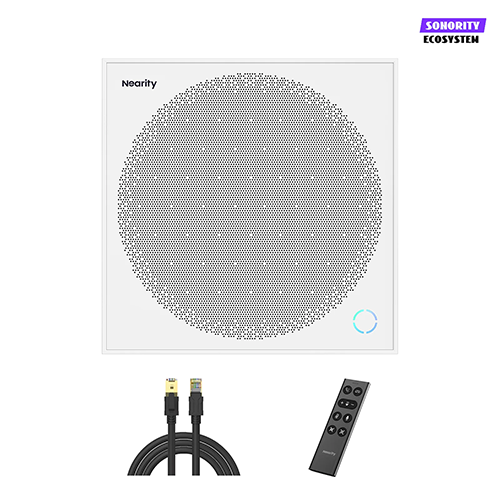This comprehensive guide examines the evolution and advantages of ceiling microphones in modern conference environments. Beginning with an overview of multi‑capsule beamforming and embedded AI processing, it outlines how ceiling mics transform meeting rooms into clutter‑free, acoustically optimized spaces. The pros and cons section evaluates installation, cost, and system integration challenges against enhanced audio clarity, echo cancellation, and aesthetic appeal. Detailed feature criteria—such as capsule count, DSP capabilities, spatial audio, PoE support, and virtual zone configuration—prepare readers for informed purchasing decisions. Finally, four top 2025 systems are reviewed in depth to suit diverse budgets and room sizes, empowering organizations to elevate their conference audio infrastructure.
Ever been on a call where someone’s voice fades in and out? Wonder if that “mic hanging from ceiling” can really pick up everyone around the table? Or worry that echo and background noise will make your next big presentation sound amateurish? You’re not alone. In today’s hybrid world, clear, consistent audio isn’t just a “nice to have”—it’s essential for productivity, engagement, and a polished professional image.
In this guide, we’re diving deep into the world of ceiling mics. We’ll weigh the pros and cons, explain how a conference room ceiling microphone works, highlight the key features you should look for, and showcase four top-tier models for 2025.
What Is the Ceiling Microphone?
A ceiling microphone is a suspended audio pickup device installed flush with or below the ceiling tile.
– Ceiling microphones transform your meeting room into a cable‑free zone by capturing sound from above, rather than cluttering the table with tabletop mics.
– They use multi‑element arrays and digital signal processing to focus on voices and ignore ambient noise, making them ideal for hybrid meetings, classrooms, and boardrooms.
The Pros and Cons of Ceiling Microphone
✅ Pros
- Full‑room coverage: An array of capsules and beamforming technology captures voices across 360°, reducing “dead spots.”
- Hands‑free convenience: No more leaning toward a tabletop mic or passing a handheld around.
- Aesthetic appeal: Flush‑mount design blends into standard ceiling tiles—no distracting hardware.
- Scalability: Connect multiple units via PoE Ethernet or Dante network for larger rooms.
- Consistent audio levels: Built‑in automatic gain control and DSP echo cancellation keep voices balanced.
❌ Cons
- Installation complexity: May require running Ethernet or audio cables above ceiling tiles.
- Upfront cost: High‑end models with advanced AI noise reduction can be pricier than tabletop alternatives.
- Room acoustics sensitivity: In highly reverberant spaces, you might need acoustic treatment or additional echo suppression.
- Technical setup: Integrating with existing AV systems demands some AV network know‑how.
- Maintenance access: Servicing in-ceiling hardware means accessing ceiling panels.
Despite a few hurdles, the overall lift in audio quality and user experience often justifies the investment—especially in critical conference settings.
How Does a Conference Room Ceiling Microphone Work?
At its core, a microphone from ceiling uses an array of small capsules, DSP processing, and network protocols to deliver pristine audio:
- Beamforming Array Multiple condenser capsules detect sound at slightly different times. The DSP analyzes these phase shifts to “steer” virtual beams directly at active speakers, suppressing off‑axis noise.
- Edge Computing & AI Modern ceiling mics, like Nearity’s A31S‑C, include embedded processors that run AI‑driven noise reduction, echo cancellation, and feedback suppression algorithms in real time.
- Network Audio Delivery Audio streams are encapsulated in IP packets over PoE Ethernet or AV over IP (AoIP) protocols like Dante. This ensures low‑latency, high‑fidelity transport to your mixer or conferencing platform.
- Virtual Microphone Zones Advanced systems let you define virtual pickup zones—dynamic 5 cm grids that adapt as participants move. This virtual mic technology helps keep every voice clear, wherever people sit.
- Integration & Control Centralized management interfaces (web GUIs or room controllers) allow you to adjust gain, mute zones, and update firmware without climbing a ladder.
The Key Features of a Ceiling Mic
When shopping for a ceiling mic, look for these must-have features to future‑proof your conference room:
- Beamforming & Array Design – At least 8–16 capsules for precise directionality – Adaptive beamforming to track moving speakers
- Advanced DSP Processing – AI noise suppression, human-voice prioritization – Echo cancellation & automatic gain control
- 3D Spatial Audio Capture – Immersive audio support for hybrid events – Multi‑layer spatial processing for distance correction
- Network Connectivity – PoE (Power over Ethernet) for simple installs – Dante/AoIP or SIP support for scalable setups
- Virtual Microphone Technology – Software‑defined pickup zones – Dynamic grid recalibration as participants move
- User‑Friendly Management – Web‑based configuration panels – Remote firmware updates & SNMP monitoring
Make sure each spec aligns with your room size, network infrastructure, and collaboration platform.
High-Quality Mic Hanging from Ceiling 2025 for conferences
Below are four standout conference room ceiling microphone systems of 2025, each offering five key features to suit different budgets and room sizes.
Nearity Sonority Audio Ecosystem A31S-C —— The Ultimate Multifunctional Network Array Microphone

- Advanced Edge Computing – On‑board AI chip for real‑time voice detection and processing.
- AI‑Driven Noise & Echo Suppression – Proprietary algorithms remove background noise and echo within an 8 m radius.
- 3D Spatial Audio Capture – VoiceCAP Pro 3D maintains stable pickup in challenging acoustics.
- Robust PoE Networking – Supports up to 8Pcs A31S‑C unit microphones via PoE Ethernet; scalable Dante and AV over IP compatibility.
- Virtual Microphone Zones (Clairaudience) – 5 cm grid technology adapts to participant movement for uniform clarity.
Yealink CM50 Ceiling Microphone —— Ultra Coverage, Intelligent Deployment, and Native Teams Integration

- 127‑Element Beamforming Array – Omnidirectional capsules with 8 software‑defined pickup zones.
- Acoustic Environment Adaptation – Room Designer software tailors tuning to each space.
- Microsoft Teams Native Support – Auto‑EQ switching, mute sync, and camera tracking.
- AI Voice Optimization – In‑house noise reduction and echo cancellation model.
- Sound Reinforcement Ready – Defines reinforcement zones; AI feedback suppression for clear amplification.
Biamp Parlé TCM-XA Ceiling Speakerphone —— Low‑Profile Design Meets Intelligent Beamtracking

- Sleek 150 mm Diameter Profile – Virtually disappears in standard ceiling tiles.
- Out‑of‑Box Beamtracking – Actively follows voices without manual lobe aiming.
- 4 × 90° Pickup Zones – Complete 360° coverage with independent DSP per zone.
- Integrated DSP & PoE+ Amplifier – Network box provides 2 DSP channels and power (up to 40 W peak).
- UL 2043 & RoHS Compliance – Air‑handling space rating and eco‑friendly credentials.
Sennheiser TeamConnect Ceiling 2 —— Trusted Sennheiser Audio Quality in a Modular Design

- Patented Dynamic Beamforming – Have Exclusion and priority zones plus camera control via talker data. Automatically adapts lobes to active speakers.
- TruVoicelift Function – Maintains consistent loudness even across large rooms.
- 28 German‑Made Electret Capsules – Highest speech intelligibility and frequency response.
- Dante & PoE Connectivity – Flexible analog output and AV over IP integration.
- Certified for Teams, Zoom & More
Conclusion
A ceiling microphone transforms your conference space into a professional audio hub—no more uneven volume, distracting background hum, or tangled microphones on the table. Whether you choose the AI‑powered flexibility of Nearity’s A31S‑C, the smart deployment of Yealink CM50, the discreet beamtracking of Biamp Parlé, or the trusted quality of Sennheiser’s Ceiling 2, you’re investing in clearer communication and more engaging meetings.
Ready to upgrade? Explore our full range of audio solutions or get in touch with our experts for a custom consultation. Elevate every word—because your message deserves to be heard.
Learn More
Ceiling Mic Installation Methods
Demystifying the Role of an Audio Visual Technician: Beyond IT Management
Understanding AGC, AEC, and ANC: The Three Pillars of Audio Enhancement
Zoom Audio Not Working: Troubleshooting Guide With Four Simple Steps
What’s the Best Speakerphone for Zoom Meetings? Top Picks for Every Room Size
























